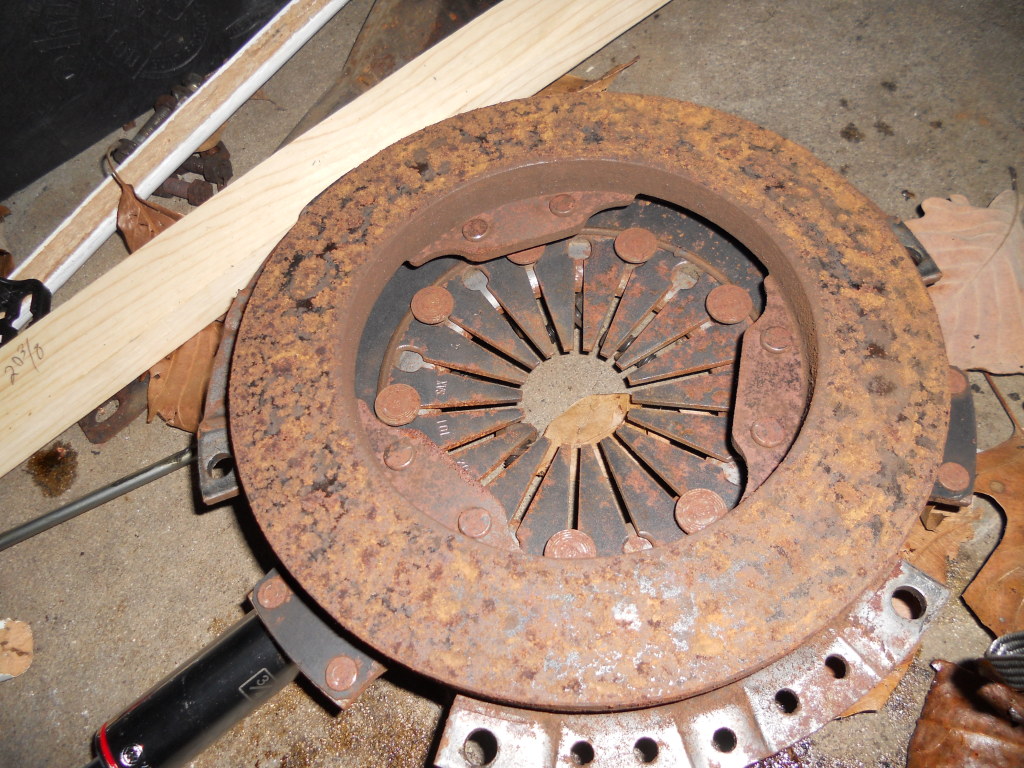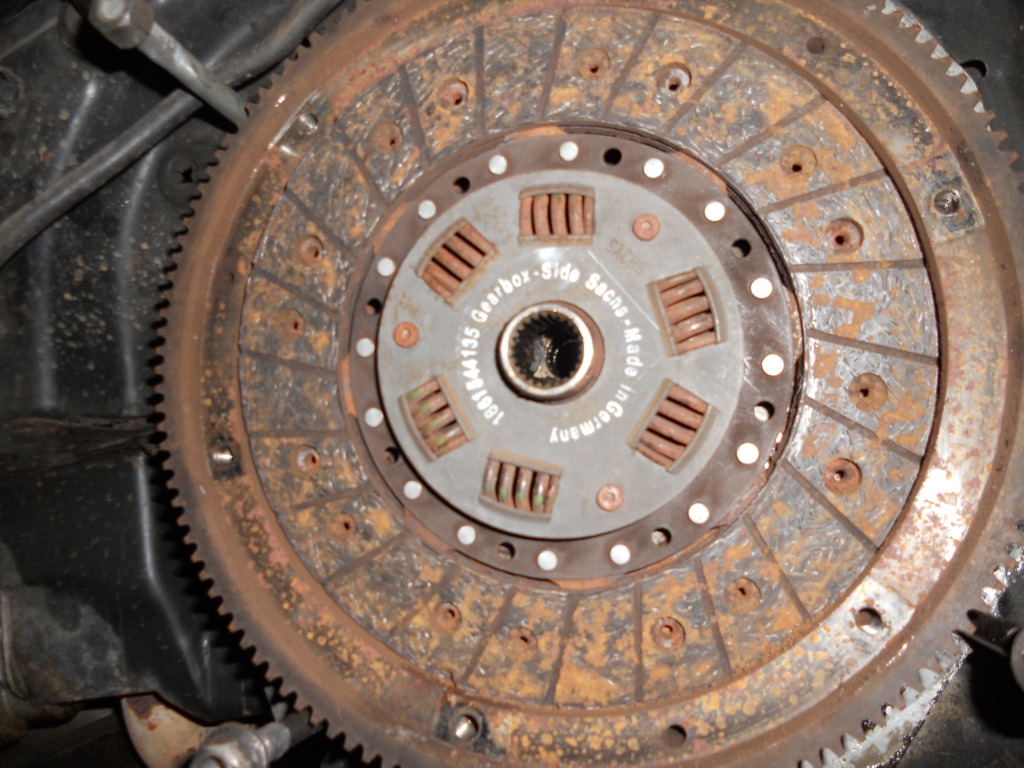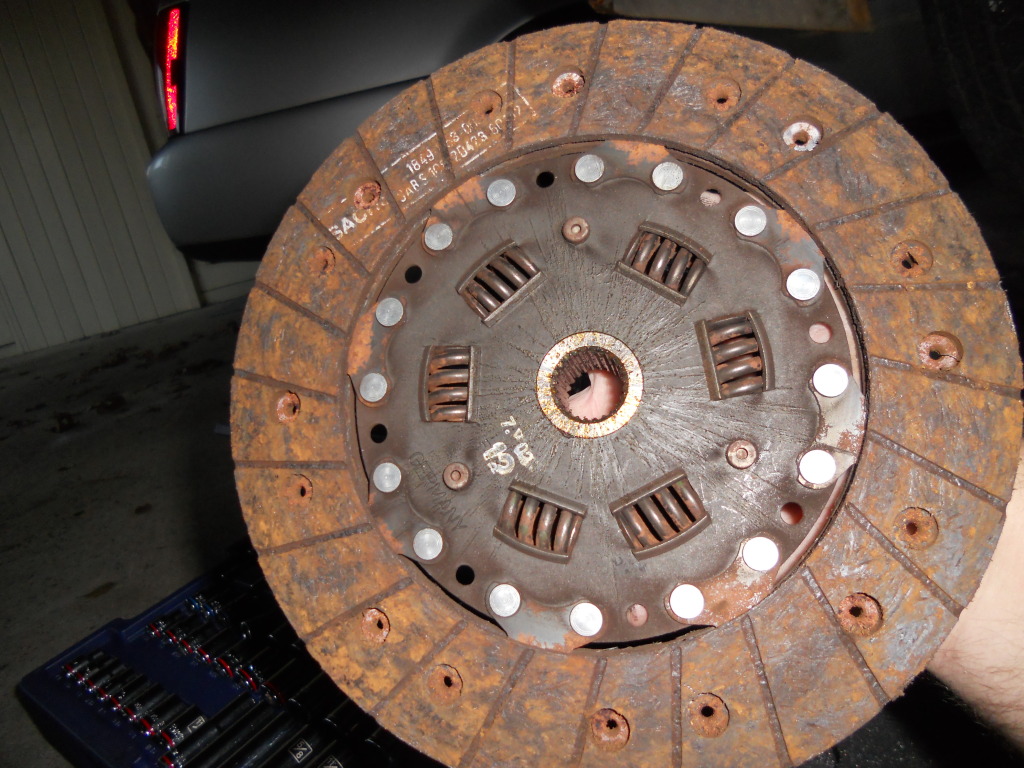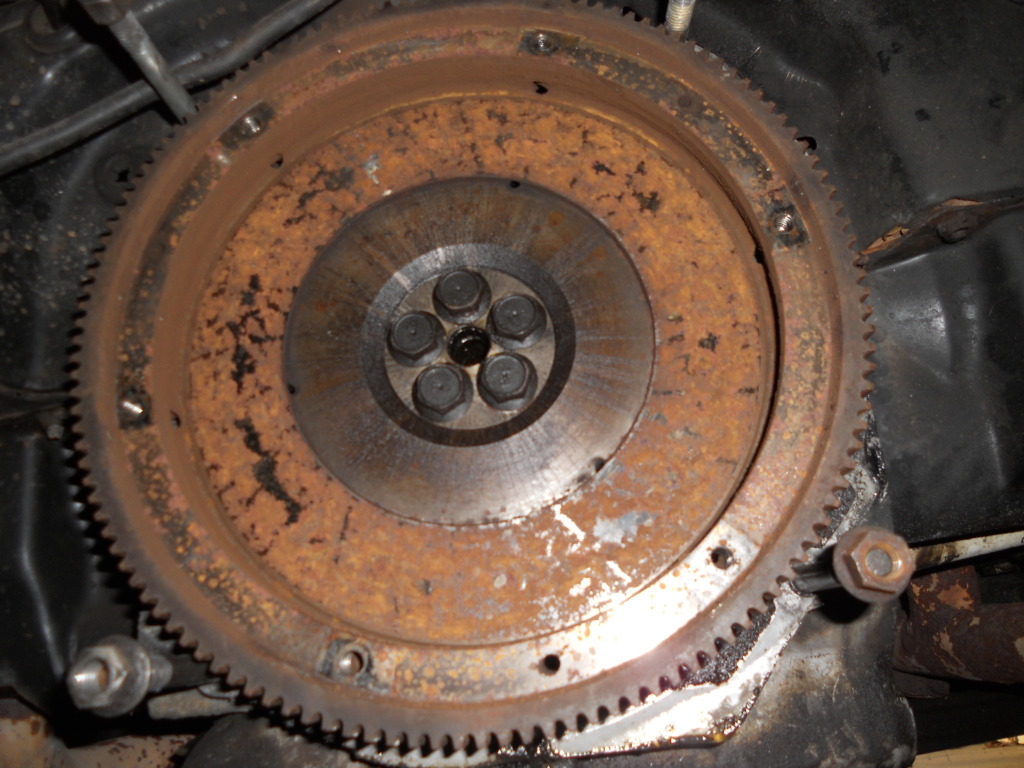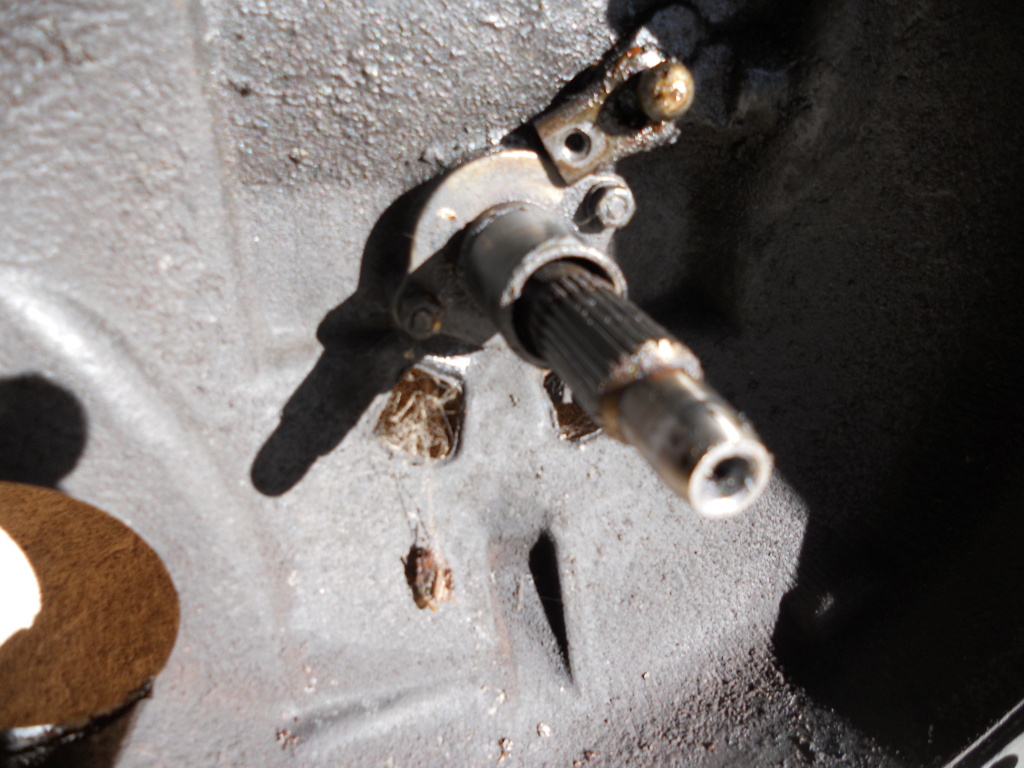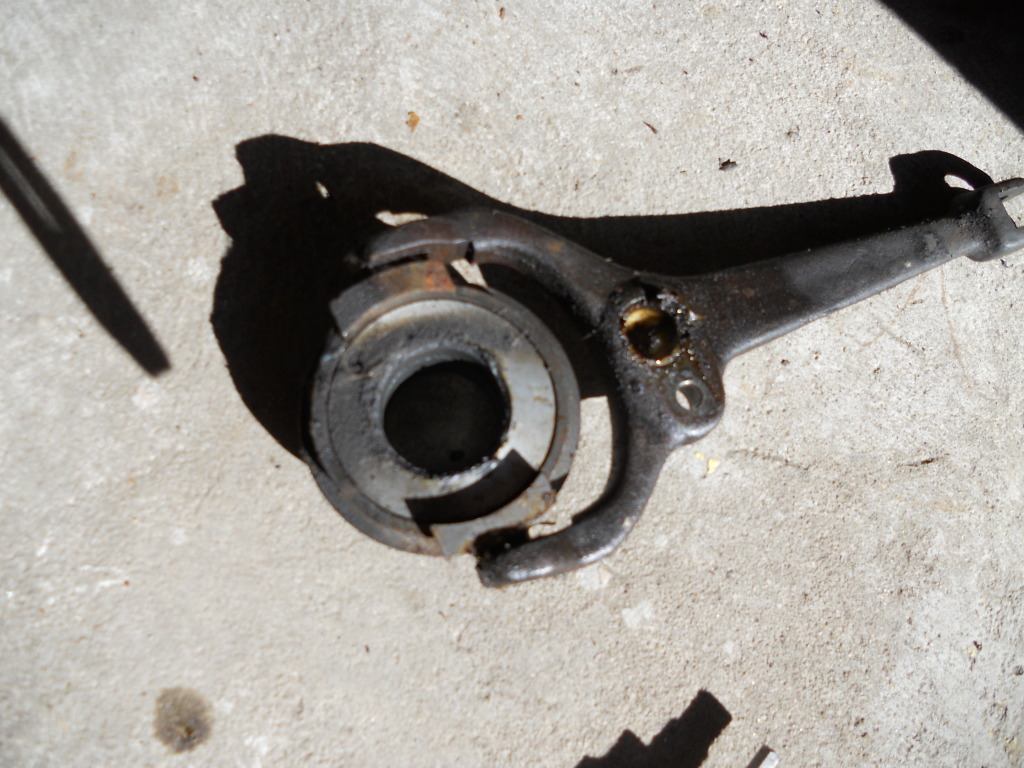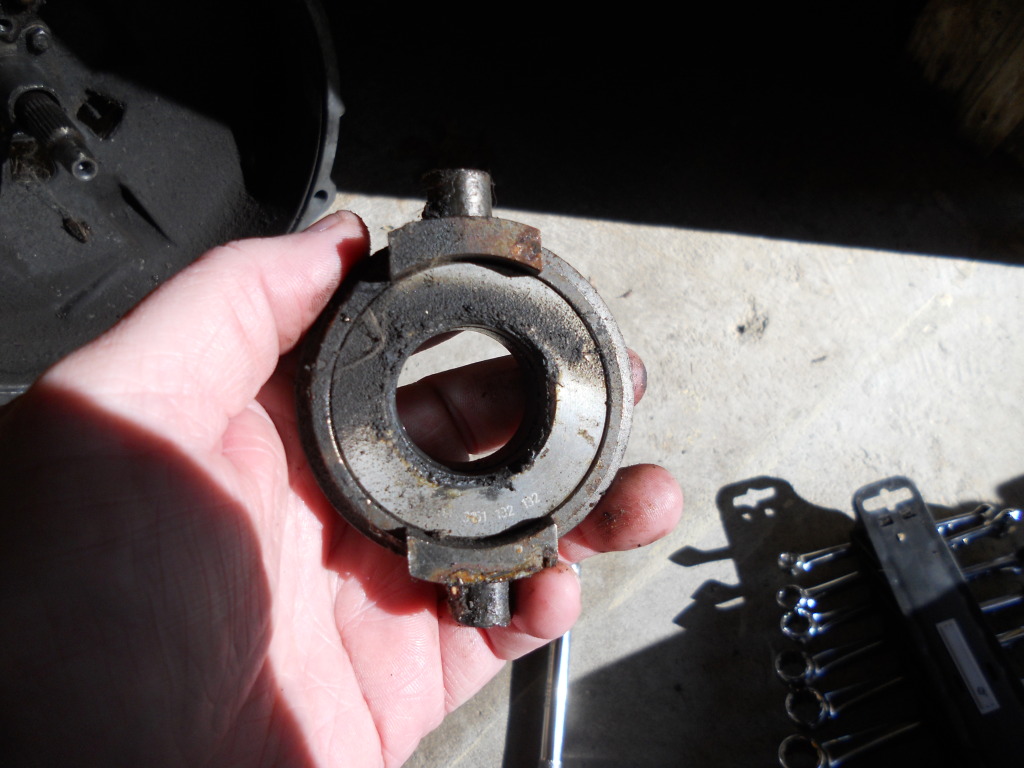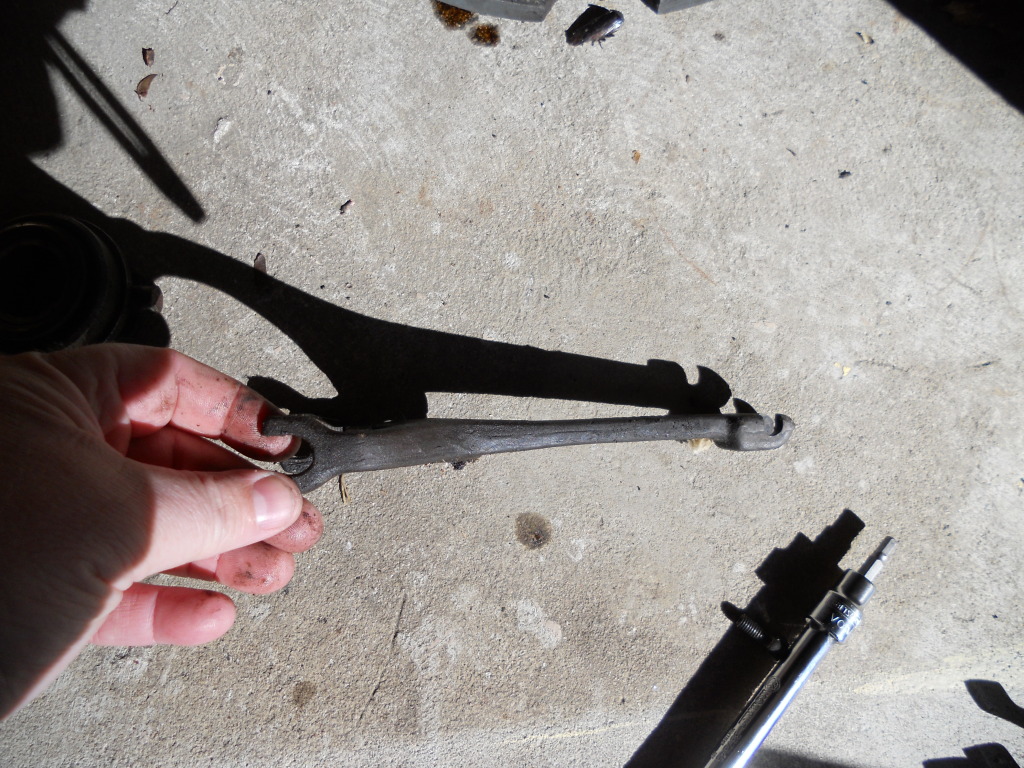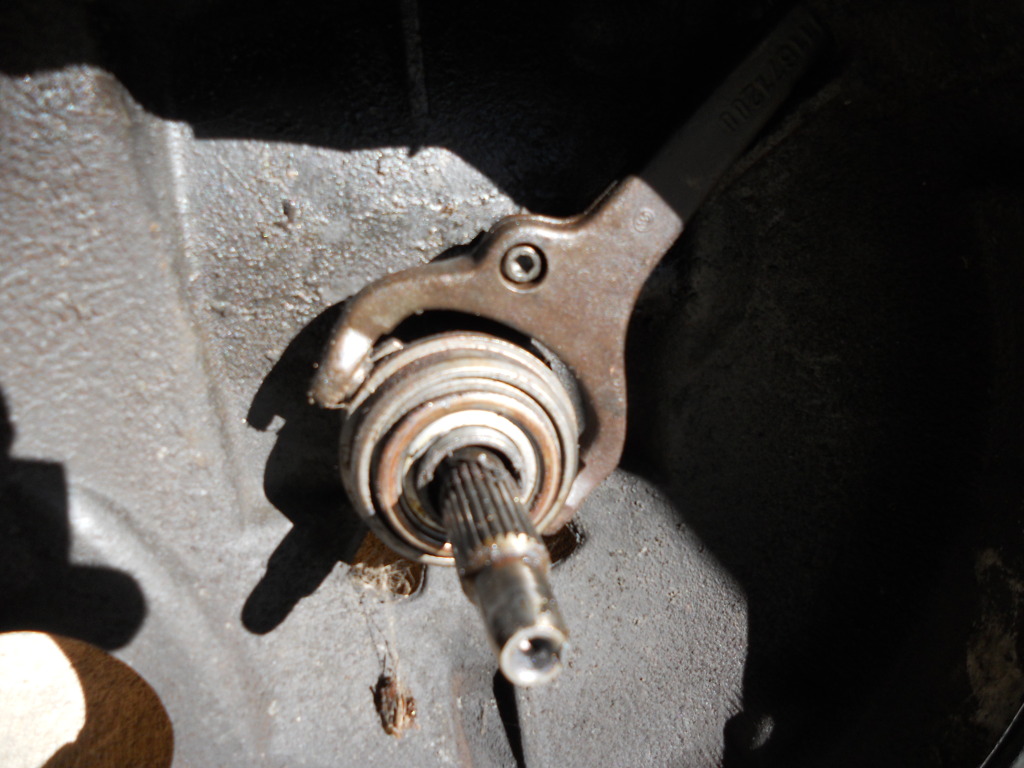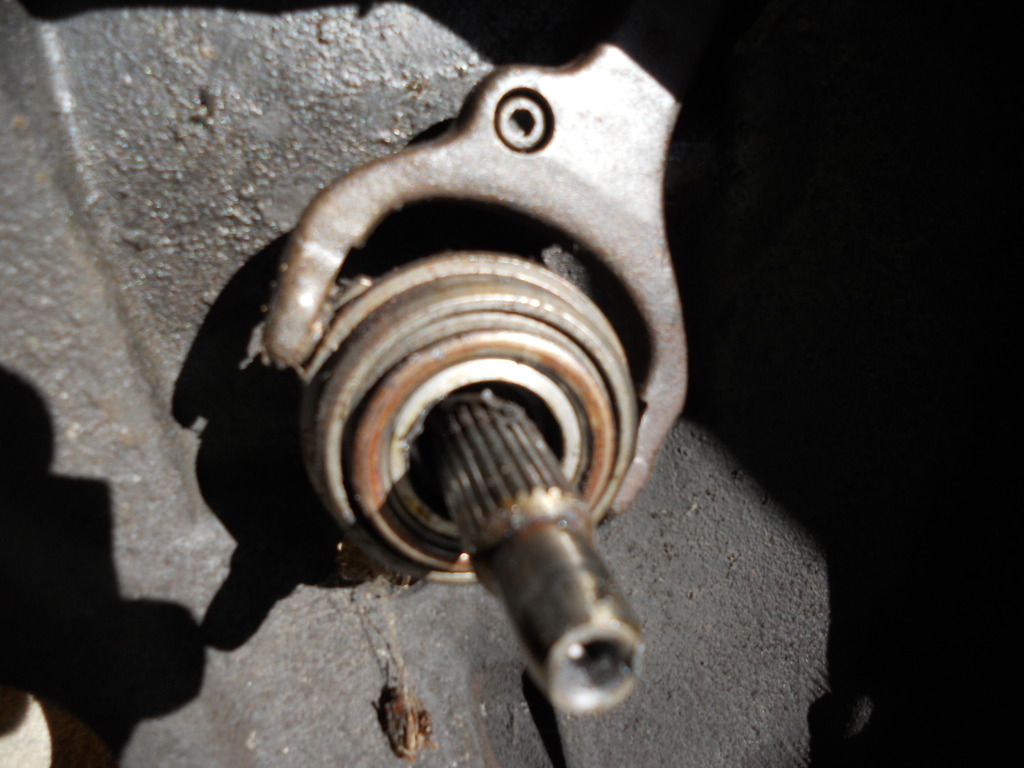billh1963
Jan 14 2012, 04:46 PM
76-914
Jan 14 2012, 06:10 PM
That disc looks new. Howe bout a side shot of both. I can't tell if the fingers are flat in this shot.
billh1963
Jan 14 2012, 06:28 PM
underthetire
Jan 14 2012, 06:31 PM
Don't know, but I'd put a new input shaft seal on that thing unless you like pulling transmissions.
wingnut86
Jan 14 2012, 07:43 PM
...yeah, but that whole "...Gearbox - Side..." statement is more like "GUIDELINES"...
The back side of the clutch disk where the rivets come through, are some of the rivets rusted out or split down the middle?
Take the clutch fork off and inspect the cup clip/keeper whatch-a-ma-callit on the back. Is the ball still in place under there and torqued down into the bell housing of the tranny?
I wonder if that flywheel was:
A) Resurfaced to spec (image attached)?
B) The correct flywheel for that motor?
Click to view attachmentDr. Evil is better set for these responses, but I did read all his notes 10 times forward and backward. Ummm, with analgesics by Dos Equis.

JamesM
Jan 14 2012, 08:13 PM
Cant tell a whole lot from the picture but it looks like you are missing your throwout bearing guide clips 901-116-825-11. Probably not the source of your problem but the clutch fork does get a bit wobbly without them. I would also check the ball cup busing under the fork 901-116-741-01.
If you dont know the history of the pressure plate i say replace it. I used a "rebuilt" one from a parts stash i was given and it wound up bitting me in the ass, I got really good at pulling the trany trying to track down the problem.
Replace the bushings and pressure plate then shim the fork piviot until you get the right amount of freeplay in the fork.
JRust
Jan 14 2012, 08:19 PM
To me it looks like the tines (not the right word but all that came to mind) are depressed. Looks to me like it was somehow engaged all the way. Then rusted in place. I may be completely off base which wouldn't surprise me in the least. Just looks like everything rusted together keeping it completely stuck. The pilot bearing in that case moves all the way forward without engaging the pressure plate

. That is my stab at it & I do not claim to be very smart

billh1963
Jan 14 2012, 08:33 PM
QUOTE(JRust @ Jan 14 2012, 09:19 PM)

That is my stab at it & I do not claim to be very smart

Well.....
I'm not smart at all...that's why I'm appreciative of all opinions!

mrholland2
Jan 14 2012, 08:42 PM
Clutch parts are relatively cheap. I'd buy a correct pressure plate, clutch plate, and throwout bearing, de-rust the flywheel surface and button it all up.
QUOTE(billh1963 @ Jan 14 2012, 02:46 PM)

Okay...pulled pressure plate tonight and this is what I found. Yes, I know it's rusty!

Was the clutch plate in correctly? One side is stamped "Gearbox Side" and it was facing the transmission. Anything stand out as being wrong?
busmech
Jan 14 2012, 11:34 PM
I would replace everything, looks like the pressure plate is stuck in the released position. No clearance for the fingers and the rust marks dont look like the disk was touching anything.
larss
Jan 14 2012, 11:45 PM
I would also clean the surfaces at the engine and gearbox that meet when you bolt them together. Had a painted gearbox once with paint on the edge, this was enough to give the fork a strange angle.
/Lars S
bigkensteele
Jan 15 2012, 12:23 AM
It doesn't look like your disk is the problem. If there is a problem, I would say that it is your pressure plate. The reason I say "if", is because I am not sure you have a problem at all. Are you sure that you adjusted the cable correctly? Refer to Doc Evil's write-up in his signature.
SchantzMD
Jan 15 2012, 03:53 AM
I actually saw this same issue on a 914 before that had a "fresh" clutch. The symptoms were the same and the problem turned out to be that the machinist didn't remove the correct amount of material from the upper pressure plate mounting lip on the flywheel.
Since it looks like you may have a new old clutch, and since you're missing the 3 pressure plate alignment pins, it's possible that you have the same issue.
To verify this, check the measurement from the lip where the pressure plate bolts to where the clutch disc makes contact with the flywheel, it should be ~.885". If you find it measures out to be a lot less than that's probably your issue.
Hope this helps and good luck on knocking off the 100lbs of rust!

.
QUOTE(billh1963 @ Jan 14 2012, 02:46 PM)

Okay...pulled pressure plate tonight and this is what I found. Yes, I know it's rusty!

Was the clutch plate in correctly? One side is stamped "Gearbox Side" and it was facing the transmission. Anything stand out as being wrong?
reharvey
Jan 15 2012, 06:54 AM
QUOTE(busmech @ Jan 15 2012, 12:34 AM)

I would replace everything, looks like the pressure plate is stuck in the released position. No clearance for the fingers and the rust marks dont look like the disk was touching anything.

Replace everything including the flywheel. It's all a mess. Ray
ChrisFoley
Jan 15 2012, 09:09 AM
I don't think you need to replace anything - if - you clean up the friction surface on the PP and it isn't substantially pitted, and a machinist can correct the incorrect step distance between the bolt surface and friction surface without over-thinning the flywheel.
I like to use a flex-hone made for brake rotor cleaning to clean up clutch friction surfaces.
jflash914
Jan 15 2012, 09:23 AM
Some of the observations that are obvious from your pictures are:
1) The dowel pins are missing from your flywheel which may indicate that it possibly was resurfaced previously. When they are resurfaced the machinist should take off the same amount of material from the clutch disc surface and the surface where the PP resides. After the resurfacing the dowel pis are reinstalled.
2) As previously guys have mentioned the bushings are missing that support the TO bearing. This will make the fork loose on the TO bearing.
3) One of the critical items that we cannot see from your pictures is the back side of the clutch fork. If the bushing is destroyed or missing this will prevent the fork from moving far enough toward the PP. If so the TO bearing will not contact the fingers on the PP hard enough to release the clutch.
If you get a chance take a pic of the backside of the clutch fork.
Hopefully you will make some sense of my ramblings.
Good Luck,
Jack
billh1963
Jan 15 2012, 09:33 AM
QUOTE(Racer Chris @ Jan 15 2012, 10:09 AM)

I don't think you need to replace anything - if - you clean up the friction surface on the PP and it isn't substantially pitted, and a machinist can correct the incorrect step distance between the bolt surface and friction surface without over-thinning the flywheel.
I like to use a flex-hone made for brake rotor cleaning to clean up clutch friction surfaces.
The engineer in me wants to replace all the parts. However, when I look at the parts I believe that they are brand new....and I would like to save them if I can.
I appreciate all the comments. Just to pull everything together:
1. When I bought the car the clutch wpuld not disengage. You can start it in gear and drive it....you just can't disengage the clutch
2. I bought the car from a young guy in the Army who bought it from a friend in the same condition. It has not been driveable for a while.
3. The car has a new clutch cable
4, The clutch fork moved freely from front to back...there was no resistance in the range and never even felt like it was contacting the pressure plate "fingers"
5, The pictures I have included in the three threads I have posted on this issue shows the progress of disassembly...from transmission attached through the removal of the PP
6. My next plan of attack is to measure the critical dimensions of the flywheel and see if there is an issue there.
I could reassemble it; however, if I don't replace anything there is no expectation that anything will change. Clearly, something is incorrect or missing. The challenge is finding that missing or incorrect component!
Cap'n Krusty
Jan 15 2012, 10:21 AM
Besides all the other stuff pointed out as wrong, the disc was probably stuck to the flywheel. Even if the pressure plate was releasing and the measurements were all within specs, the disc would be turning with the flywheel and that means the mainshaft would be "hooked up", preventing the transmission from being shifted while the engine was running.
The Cap'n
billh1963
Jan 15 2012, 10:41 AM
majkos
Jan 15 2012, 10:44 AM
A good cleaning is in order.

Let's see what you have to work with.
jflash914
Jan 15 2012, 10:54 AM
Billh1963,
The clutch fork looks normal except for the missing TO bearing bushing.
Jack
billh1963
Jan 15 2012, 12:26 PM
TO Bearing Bushing?
euro911
Jan 15 2012, 12:43 PM
Bill, I posted some suggestions on one of your 'other' threads on the same subject:
http://www.914world.com/bbs2/index.php?s=&...t&p=1605003"Your clutch disc doesn't look too bad. Check it's total thickness and wire brush it if it's within spec. It appears to have been installed in the correct orientation.
I'd try to find another pressure plate. It's hard to say from the pix, but I think yours may have lost it's 'elasticity'. Verify with a known good one, or a knowledgeable automotive person or machine shop.
Check your TO bearing - if it spins OK, and doesn't have side play, it may still be usable.
The flywheel should be measured (at several key locations) to see if it can handle another resurfacing (looks like it's getting close to being at the end of it's life) - again, kind of hard to tell from the pix if it has enough good meat left or not. A reputable machine shop could tell you right away if it's good or bad.
Whether you can get by with resurfacing it or need a new (or good used) one, you'll still need all the 'small items' on the list posted earlier.
It looks like you would benefit from a new front (input shaft) seal on the transaxle too.
While you have the transaxle out, check and replace the (2) output shaft seals if they're leaking ...Good luck ...
billh1963
Jan 15 2012, 01:59 PM
QUOTE(wingnut86 @ Jan 14 2012, 08:43 PM)

A) Resurfaced to spec (image attached)?
B) The correct flywheel for that motor?
Click to view attachmentMeasured the flywheel today...I get 19.8mm for measurement "a"
Anyway, I'm wondering if I have the correct flywheel?
Not enough depth for the clutch to release? That still wouldn't explain the clutch fork not having any resistance, would it?
underthetire
Jan 15 2012, 02:29 PM
The flywheel has been machined too deep, both surfaces. You can see in one of the pics the head of the pressure plate bolts are way below the flywheel surface. Doing so, you need to shim the pivot ball if there is still enough room or find a new flywheel.
billh1963
Jan 15 2012, 02:37 PM
I'm going to look for another flywheel!
The PP and disc are new...I'm foing to try to reuse those. I'll be looking for the missing parts and go from there.
I need:
-flywheel
-flywheel dowels
-TO bearing clips (2)
-TO bearing bushing
- assorted gaskets
Guess I'll start checking the classifieds!!
underthetire
Jan 15 2012, 03:25 PM
Don't forget the flywheel oring, and the crush gasket thingy under the bolt heads. And a input shaft seal!
billh1963
Jan 15 2012, 03:54 PM
QUOTE(underthetire @ Jan 15 2012, 04:25 PM)

Don't forget the flywheel oring, and the crush gasket thingy under the bolt heads. And a input shaft seal!
I'm sure there will be a long list of little "While I'm in there" things as well as the "must do's"....

majkos
Jan 15 2012, 04:10 PM
No, not really, we got you covered there

Dr Evil
Jan 15 2012, 04:17 PM
Dowels come on the flywheel, usually

The TOB clips/bushings are the same thing - they go on the sides of the TOB between the TOB and the fork.
Dr Evil
Jan 15 2012, 04:21 PM
QUOTE(underthetire @ Jan 15 2012, 03:29 PM)

The flywheel has been machined too deep, both surfaces. You can see in one of the pics the head of the pressure plate bolts are way below the flywheel surface. Doing so, you need to shim the pivot ball if there is still enough room or find a new flywheel.
I dont think it has been machined too far. The bolt heads for the flywheel are still not machined down and the disk seems to be missing them. I have seen them machined more.
If the flywheel is not pitted from rust too bad, check the measurements as previously posted.
billh1963
Jan 15 2012, 05:24 PM
The frustration I am feeling is that, so far, there is no "smoking gun". There is nothing that has produced a unanimous shout of, "Eureka"!
There are small things wrong (flywheel dowels, TO bearing clips, etc.); however, none of these would have created the problems that caused two owners to give up on the car.
I guess I should ask this...when the car is at rest, how far should the clutch fork normally move (when the clutch cable starts pulling on it) before it starts encountering resistance?
Dr Evil
Jan 15 2012, 05:40 PM
There is a distinct possibility that someone already mentioned. If your flywheel was machined, and we believe it was, and the pivot ball of the TOB fork was not shimmed out, then you would not have enough throw to disengage the PP. I cover this in my notes in more detail, but that would be my first thought on this as I have seen it several times and it often leads to despair as it is not very obvious.
If your clutch fork would move all the way when everything was assembled, and still not push much on the PP to disengage the PP, then you have your answer.
billh1963
Jan 15 2012, 05:51 PM
QUOTE(Dr Evil @ Jan 15 2012, 06:40 PM)

There is a distinct possibility that someone already mentioned. If your flywheel was machined, and we believe it was, and the pivot ball of the TOB fork was not shimmed out, then you would not have enough throw to disengage the PP. I cover this in my notes in more detail, but that would be my first thought on this as I have seen it several times and it often leads to despair as it is not very obvious.
If your clutch fork would move all the way when everything was assembled, and still not push much on the PP to disengage the PP, then you have your answer.
That sounds like as good a starting point as any. I'm going to "derust" the flywheel and PP, get some new gaskets and parts, and see what happens. It won't take but a few minutes to rehang the transmission and hook up the clutch cable to see if the TO bearing hits the PP.
bozo914
Jan 15 2012, 05:57 PM
It is not the TO bearing clips, it is not the lack of dowels. The dimension between the mounting surface if the pressure plate and the clutch surface is too short for the pressure plate. When you first opened it up, the fingers were depressed, just as if you had pressing the TO bearing against it ie: engaging the clutch, releasing the disk, yet the disk wasn't free. What is sup[posed to happen is move the shoe (the heavy ring that clamps the disk to the flywheel when free) away from the flywheel releasing the disk to spin freely. Again, it's either the flywheel was machined wrong (needs more taken off of the disk area) or the PP is funky. Find another PP, even an old one, lay it face down (shoe side down) and measure how far up the mounting flange is off of the surface. See if that dimension is close to yours. I'm betting it isn't.
billh1963
Jan 15 2012, 06:06 PM
QUOTE(bozo914 @ Jan 15 2012, 06:57 PM)

It is not the TO bearing clips, it is not the lack of dowels. The dimension between the mounting surface if the pressure plate and the clutch surface is too short for the pressure plate. When you first opened it up, the fingers were depressed, just as if you had pressing the TO bearing against it ie: engaging the clutch, releasing the disk, yet the disk wasn't free. What is sup[posed to happen is move the shoe (the heavy ring that clamps the disk to the flywheel when free) away from the flywheel releasing the disk to spin freely. Again, it's either the flywheel was machined wrong (needs more taken off of the disk area) or the PP is funky. Find another PP, even an old one, lay it face down (shoe side down) and measure how far up the mounting flange is off of the surface. See if that dimension is close to yours. I'm betting it isn't.
What you are saying is viable as well. I guess if the fingers were already "depressed", the TO would not be able to reach them. I don't have an old PP so I'm going to post some pics with measurements:
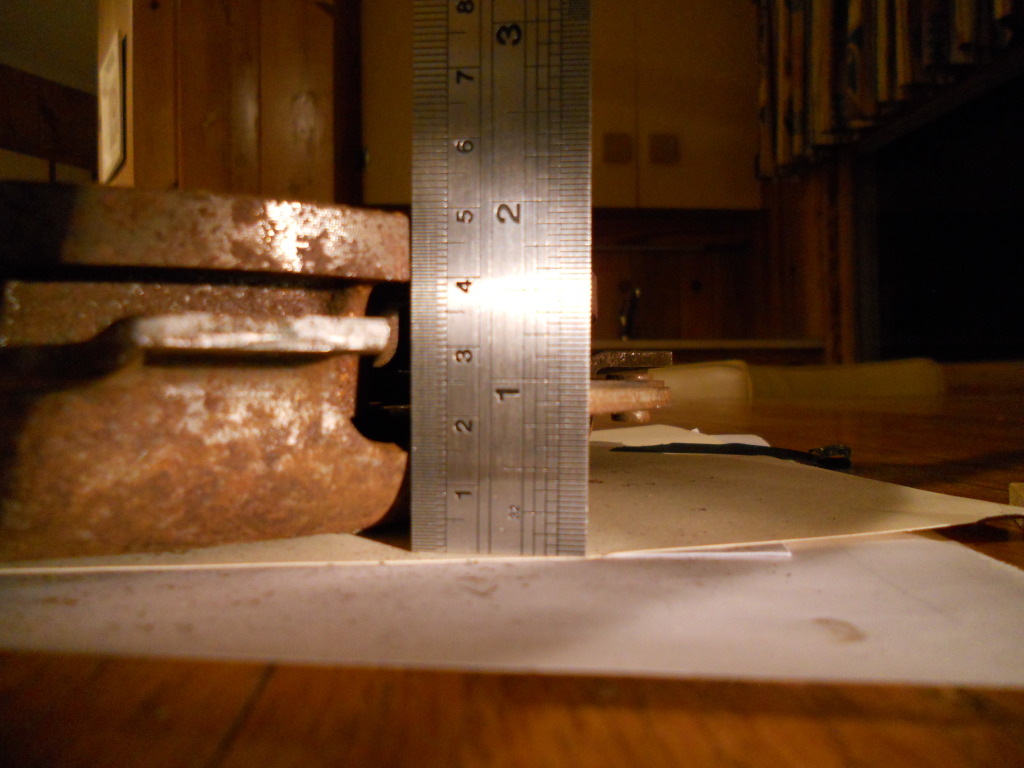
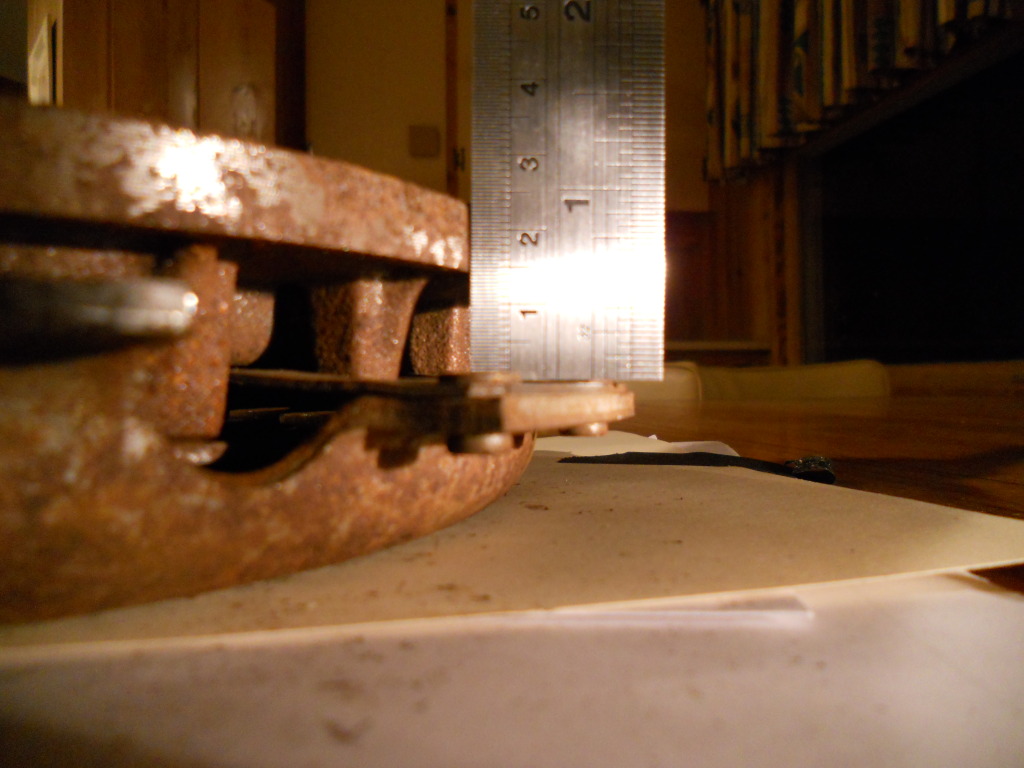
wingnut86
Jan 15 2012, 06:27 PM
Bill,
Load your car with all the bits and pieces and come up after work in O-Burg to my house. I have a couple of flywheels, plus one I had re-surfaced recently. I also have a lightened and balanced setup, but, that's probably not the one we would want to use for "Guidelines"

FYI - The district NAPA warehouse/shop is right off I-26. The machinist there runs a hell of a lot of metal through there weekly, doing bike heads to tractor blocks. The volume is staggering and his skill always surprises me when I stop by.
There's also a super secret modern fabrication facility close by as well that will do any custom work you want for the $$$. I don't share this place normally, ie - I ain't gonna mention it here, cause their customers are not usually hot rods and foreign skates.
Let me know.
Dave
billh1963
Jan 15 2012, 06:34 PM
Thanks, Dave. I may do that if we can't solve this problem through pictures!

I haven't pulled the flywheel yet...trying to avoid that for now!
ChrisFoley
Jan 15 2012, 06:38 PM
19.8mm x 25.4 = .780". That's a hundred thou less than specified in the other thread. There's your problem.
Make sure the cup bushing in the fork isn't cracked. If it wasn't replaced by the PO it probably should be now.
When a flywheel has been machined, a shim washer (sometimes two) is required beneath the ball to move it outward so the fork will move the TO bearing enough to disengage the clutch. The ball is actually the head of a bolt screwed into the trans casting. Unbolt it and check for shim washers.
wingnut86
Jan 15 2012, 06:39 PM
I agree.
Just pull the motor, it's less of a pain in the ass

jlozo
Jan 15 2012, 06:40 PM
QUOTE(billh1963 @ Jan 15 2012, 03:24 PM)

The frustration I am feeling is that, so far, there is no "smoking gun". There is nothing that has produced a unanimous shout of, "Eureka"!
There are small things wrong (flywheel dowels, TO bearing clips, etc.); however, none of these would have created the problems that caused two owners to give up on the car.
I guess I should ask this...when the car is at rest, how far should the clutch fork normally move (when the clutch cable starts pulling on it) before it starts encountering resistance?
rust in not just a color !! the rust build up on both sides of the disc started pushing on the presure plate cousin it to be in the released position .
sand the flywheel and prsure plate,clean disc and reasemble,check if any thing changed

wingnut86
Jan 15 2012, 06:57 PM
Bill,
When you shim your ball, turn your head and cough.

billh1963
Jan 15 2012, 07:00 PM
I have a feeling by the time this is over I will feel like I've had one of those exams!
Dr Evil
Jan 15 2012, 08:47 PM
0396
Jan 15 2012, 11:21 PM
QUOTE(76-914 @ Jan 14 2012, 04:10 PM)

That disc looks new. Howe bout a side shot of both. I can't tell if the fingers are flat in this shot.
If my trans had issues and the parts look that looked new and had that amount of rust..

I would toss those and buy a whole new package ..
This is a "lo-fi" version of our main content. To view the full version with more information, formatting and images, please
click here.
